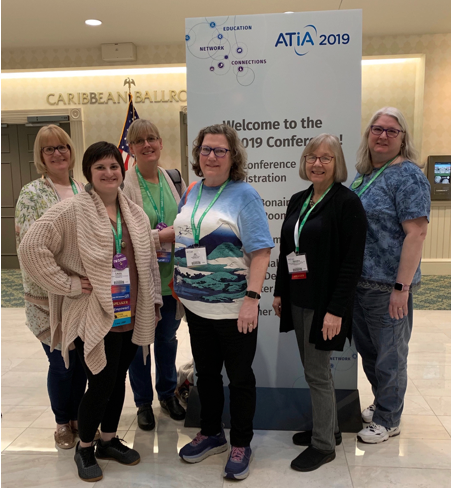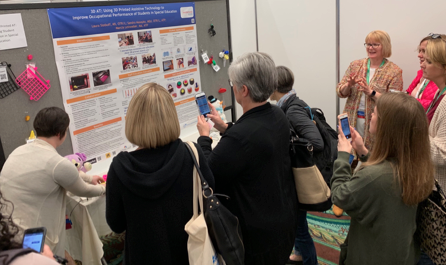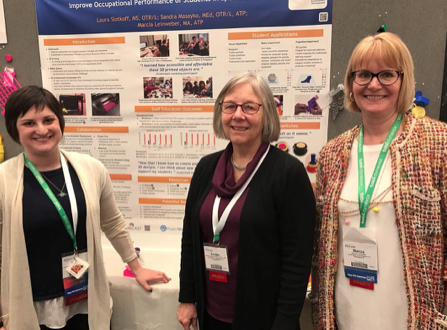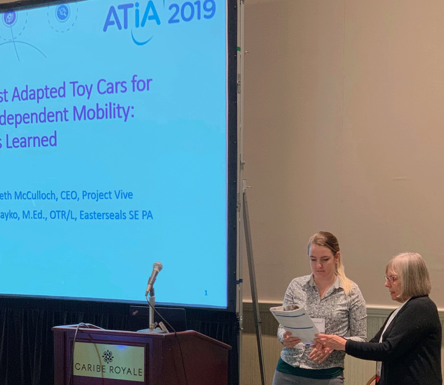by Sandy Masayko
Six staff members from Easterseals of SEPA traveled to Orlando to attend the Assistive Technology Industry Association meeting, January 30-February 2, 2019. For Laurie Spencer, Laura Slotkoff and Jo Booth, it was their first ATIA meeting; Marcia Leinweber, Laurie McGowan and Sandy Masayko were returning participants. This stimulating conference offered a wide array of learning opportunities in the field of AT, from workshops, to posters, to vendor demonstrations and networking. All participants were very pleased with the conference.
Easterseals was well represented in the area of presentation. Laura S., Marcia and Sandy presented a popular poster session on using 3D printing and AT to promote student participation. Sandy also co-presented “Adapting Low Cost Kiddie Ride-on Cars for Early Mobility: Lessons Learned” with Mary Elizabeth McCulloch of Project Vive and AbleRacers. Laurie McGowan helped instruct people who participated in AT Maker Day.
Here are some of the comments our attendees made about their learning experiences at ATIA:
Marcia:
Wow, this is hard to narrow down!
My favorite was learning more about 3D printing tactile graphics and resources available for additional tactile graphics. I enjoyed learning a variety of topics and exploring current research topics. The AT Makers Day is always a favorite. I learn so much in such a short time. The creativity and enthusiasm are inspiring.
Jo:
My absolute favorite session was the one with Karen Kangas on positioning. She totally captivated us all with her wit and base of knowledge. She gave practical tips on how to assess by throwing everything you think you know – out the door. Her point was to have a fresh eye and focus on the person and their ability to function within their environment.
Laurie S:
I second Jo’s comments.
I loved all the practical sessions. I enjoyed getting more information and resources to help with coaching teachers and TAs in implementing AAC in the classroom.
Laura S:
It’s really hard to pick just one favorite part of the conference; I feel like I came away with so many practical tools and strategies! I really liked the presentation on adaptive art tools by Judith Schoonover. We’ve only been back at Easterseals for a week, yet I’ve already had the opportunity to make several adaptations to help students better participate in art and crafts.
Laurie M:
It is always difficult to choose what to go to, and just one class as a favorite. There are so many great offerings. This year I focused on computer accessibility and note taking. I discovered that the computer industry – both Mac and PC – Google and Microsoft have really stepped up their game in accessibility for everyone. And not only are they all free tools for everyone to use, many go across platforms. This is a huge advantage for our transitioning students for OVR. I also enjoy the exhibit hall. You get to talk directly with the developers and companies, ask questions and see all the new things they are working on.
Sandy:
Networking and sharing ideas at our poster session was really enjoyable. I learned that Easterseals of SEPA is really “cutting edge” with our introduction and use of 3D printing to make assistive technology.

ATIA 2019 Easterseals of SEPA Participants, left to right: Marcia Leinweber, Laura Slotkoff, Laurie Spencer, Jo Booth, Sandy Masayko, Laurie McGowan

Our poster session about 3D printed AT was very well received. The session included AT created by 3D printing for participants to inspect and try.

The poster was created as an outcome of our Maker Space grant funded by Comcast and supported by other community partners such as Drexel, the Science Leadership Academy, Project Vive and MakerBot. Our poster will have its own blog post soon!

Mary Elizabeth McCulloch of Project Vive and Sandy Masayko of Easterseals co-presented a session titled “Low Cost Adapted Toy Cars for Early Independent Mobility: Lessons Learned.” In January 2017 Project Vive partnered with Easterseals to provide a how-to workshop on car adaptations, and the ATIA presentation shared tips for effective car construction workshops.
















